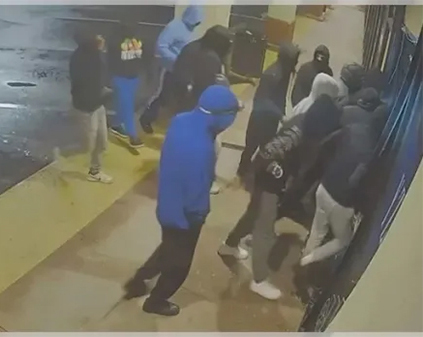By Earl Ofari Hutchinson
Contributing Columnist
Deshawn J. Snelson was angered, perplexed, but determined.
He was angered that a mob had rammed a stolen government car into the front of his Hype Kingdom apparel store in Bellflower Jan. 28. He was perplexed as to why dozens of people would choose his business for the mob robbery.
But he was determined that this would not stop him from reopening his business. The young African- American entrepreneur viewed his business as more than just a money-making enterprise. He regarded it as his way of contributing to the economic empowerment of the community, and as a spur to entrepreneurship among other young African Americans. He would not be deterred.
The mob assault on Snelson’s business unfortunately fit a growing and disturbing new pattern. This was not just a run-of-the mill snatch-and-grab theft.
In that type of crime, either a few individuals, maybe organized or at random, pick a business, rush in, and quickly grab some items and flee. In more cases than not, the thefts are not planned. Some months ago, there was an uptick in these types of crimes both nationally and in Southern California.
However, the mob robbery in Bellflower followed close on the heels of a similar robbery at a Latino-owned bakery in Compton Jan. 2. There were other reported similar types of robberies reported against other businesses.
The difference this time was twofold. The businesses targeted were Black or Hispanic owned. And they were small. This ensured vulnerability and the likelihood that the perpetrators could hit quick and flee without the risk of apprehension.
But it was the mob aspect of the robberies that was both galling and terrifying. The fact that dozens of persons knew when and where to assemble and then converge on and loot the targeted business added an entirely new dimension to crime and violence in South Los Angeles and other heavily minority communities in Los Angeles County.
It also created a new challenge and dilemma for public officials and law enforcement. Put simply, how to stop them?
The state Legislature in September 2023 allocated more than $200 million to a stepped-up campaign by law enforcement to combat snatch and grab robberies. But now with the element of a mob added to the thievery, this presented an entirely new headache for law enforcement and public officials.
The calls were for task forces, new tougher laws, mass arrests and better intelligence efforts to halt the robberies. The problem was trying to get ahead of the mob.
In snatch-and-grab thefts police simply increased patrols and the number of officers at shopping centers and in or near major department stores that had been or were likely targets of snatch and grab robberies.
That was especially the case in Beverly Hills, Santa Monica and on Melrose Avenue.
But when dealing with a mob, there was unpredictability and the near impossibility to determine what business the mob would target and when it would act.
The other problem in formulating measures to combat mob robberies is the public perception that these are just isolated occurrences. The crime figures show that burglaries and robberies have dramatically dropped in recent years. The public impression then is that thievery is way down and the mob robberies are just a small, if not insignificant, blip on the crime chart.
Yet another problem is trying to determine exactly what the motives are for those who join a mob and rush into a store and snatch and grab merchandise. In the few profiles done of those who engage in snatch and grab robberies and were arrested, there were varied motives.
Some claimed impoverishment and need. Others said they were grabbing merchandise to resell. Still others cited desperation in their living circumstances. Still others cited the ease with which they could walk out of a store with merchandise and not be apprehended. It was to them simply an opportunity theft.
There are two final dilemmas in dealing with mob robberies. Some experts caution about calling these thefts looting. The implication being that this has racial overtones and implies that the suspects involved are Black or Hispanic.
There’s little evidence that the persons who comprise the mob are exclusively minority. In most cases, their faces and bodies are heavily covered to hide their identity.
The other dilemma is the penalties for those arrested for these robberies. In some cases, they were released. In others, the charges were not much stiffer than misdemeanors. This was not exactly the type of penalty and potential sentencing that would not deter this type of lawlessness.
The sad fact is that in an era when many persons — particularly young persons — see corporations and elected officials — including a certain former president — gouging, engaging in illegal and unfair business practices and snubbing their noses at the law, sending the disturbing message that maybe crime does pay, or at least it’s easy to get away with.
If that’s the climate of the country, mob robberies are the terrifying logical hideous stepchild.
Earl Ofari Hutchinson is an author and political analyst. His forthcoming book is entitled “How Trump Wins” (Middle Passage Press). He also is the host of the weekly Earl Ofari Hutchinson Show on KPFK 90.7 FM Los Angeles and the Pacifica Network Saturdays at 9 a.m.












